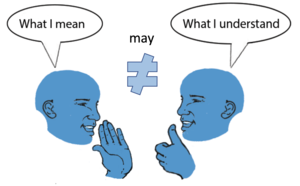
Early in my career I came face to face with the risks to project success that can occur when mutual understanding is assumed rather than actively managed. Thirty years later, lessons weren’t learned and similar organisations were repeating the same mistakes.
Case example – what went wrong?
The British Council had negotiated a teacher training project with the Chinese Ministry of Education (MoE), in which Chinese teachers of English were to be re-trained after the ravages of the Cultural Revolution. British staff were recruited to set up and run 6-month long teacher training courses in several centres in China and all seemed to go smoothly for the first few months. However, towards the end of the first year, the MoE complained to the British Council about the design of the teacher training syllabus, who then talked with the British staff. It eventually turned out that the two organisations had had different interpretations of the meaning of ‘teacher training’ yet were completely unaware of the misunderstanding at the time. To the British, ‘teacher training’ meant training teachers in the pedagogy of teaching; in other words, how to teach; to the Chinese (in this context), it meant improving the teachers’ English language proficiency. Nearly a year had been lost because both parties were guilty of one simple oversight: the need to check how others were interpreting a crucial term.
Why do such problems occur?
Why then should such problems occur? The reason lies in the nature of language and the process of communication. People often think of language as a code – assuming that messages are encoded, transmitted and decoded in a similar manner to morse code. That is not actually what happens. Meaning is not so much exchanged as negotiated. Although human communication to a large extent exploits a language code (such as English, Chinese or German), it is not feasible for everything to be conveyed explicitly in the code. Much has to be left for the speakers to work out, drawing on their background knowledge and knowledge of the context. For this reason, inferencing rather than just decoding always needs to take place.
In intercultural interaction such inferencing and ‘meaning construction’ can be particularly problematic. One key reason is because people often have different background knowledge and thus have difficulties drawing the inferences intended by others.

Overcoming misunderstandings
How then can this be overcome?
A number of elements need to be handled, but one very simple strategy is fundamental: check what others mean by any terms or concepts that are central to your negotiations. Often this can seem like overkill, yet without it projects can flounder. Fortunately, the following company did this and overcome their negotiation blockage.
We once worked with a distributed group of 32 stakeholders who were negotiating the requirements for a large online bookstore. Progress broke down over the term, “affiliate.” Stakeholders could not agree on what rights and privileges affiliates should have. It turned out that among the 32 stakeholders there were five different meanings for the term, “affiliate”. The team agreed to use a different term for each of those five meanings, and agreed that nobody would use the term, “affiliate” for the rest of the project, to minimize confusion.1
Taking this simple step often truly ensures that ‘a stitch in time saves nine’.
For reflection: in the case example, why did it take nearly one year for the feedback to reach the British staff? Clue: Other communication factors were responsible here.
For advice on other ways of minimising misunderstanding and reducing risk, get in touch with us.
Professor Helen Spencer-Oatey, Director
1 Nunamaker, J.F., Reinig, B.A. and Briggs, R.O. (2009), “Principles for effective virtual teamwork”, Communication of the ACM, vol.52, no.4, pp.113–117.


Pingback: Teamworking: What does it take to collaborate online? – GlobalPeople Consulting